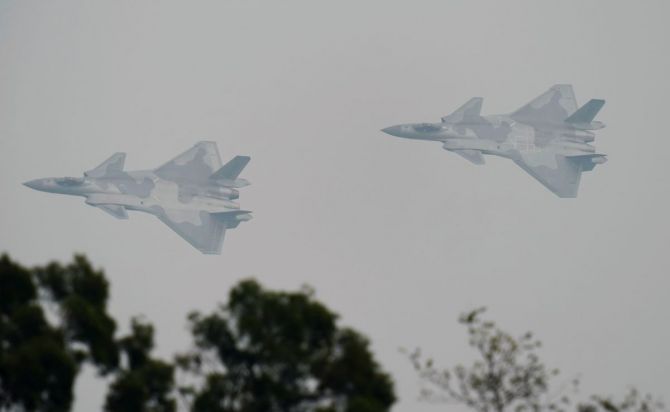Tensions between China and India along the Line of Actual Control (LAC), which boiled over into a deadly melee on June 15, have seen armies on both sides building up their strength in the Ladakh/Aksai Chin sector.

Airpower is an important consideration in case of any potential military confrontation, and China has certainly increased its air activity near the LAC.
Overall, the People's Liberation Army Air Force (PLAAF) has focused on building ground-based air defense networks and network-centric operations rather than trying to match the Indian Air Force (IAF) in terms of straight fighter numbers along the border.
All air assets fall under the Western Theater Command of the PLA, the largest geographic region of China's five military theater commands.
Andreas Rupprecht, author of Flashpoint China: Chinese Air Power and Regional Security, wrote, 'At first sight, the military importance of this [Western Theater] command might appear limited, since it covers the most sparsely populated parts of China ... However, its main importance lies in its proximity to the disputed border with India.'
Rupprecht continued, 'Bearing in mind this tense situation, one might expect numerous bases close to India. However, due to its mountainous terrain and difficult weather conditions, the Tibet Autonomous Region (TAR) area features barely any permanent major PLAAF bases.
'Nevertheless, China has established a dense airport network within the TAR, as well as a series of forward operating bases that could be used in a conflict.'
The PLAAF is thus at a numerical disadvantage to the IAF along the border, faced with daunting climatic and high-altitude challenges.
A report published by the Belfer Center at the Harvard Kennedy School estimated there were 157 Chinese fighters and armed unmanned aerial vehicles (UAV) in the Western Theater Command, although some are earmarked for Russia-directed missions.
It listed 101 fourth-generation PLAAF fighters available against 122 comparable Indian fighters.
The report's authors, Frank O'Donnell and Alexander K Bollfrass, counted eight Chinese airbases and airfields (a good portion are dual-use civil-military airports) that are relevant to strike missions against India.
Yet PLA aircraft operating from the Tibetan Plateau can only carry half their designed weapon and fuel payloads, for instance, and the PLAAF has only about 15 air-to-air tankers available nationally.
Rupprecht added, 'Although no frontline PLAAF elements are permanently based here, regular rotational deployments to the TAR are an important part of training doctrine, and these units usually come from the former Chengdu Military Region.
'This means that, in the case of a war, combat aircraft would first have to be deployed to the area, probably in coordination with a large-scale deployment of PLA ground forces with the help of the PLAAF's transport aircraft as well as civilian airliners.'
O'Donnell and Bollfrass assessed, 'In any India-China conflict, the PLA cannot launch an attack without the support of the PLAAF.
'To address its force shortfalls in the event of war, China could surge air and ground forces from its interior toward the border.
'However, what our analysis suggests is that the IAF's superiority would mean that critical logistical routes -- such as airbases and military road and rail links -- could be cut by bombing or standoff missile strikes, limiting the extent to which China's position could be reinforced.
'Such a Chinese surge would also attract attention from the United States, which would alert India and enable it to counter-mobilise its own additional forces from its interior.'
In fact, the PLAAF regards the IAF as an offensive arm, especially as it can rapidly deploy to conflict zones and be operational with little advance warning.
Yet China would be forced to concentrate its aircraft in just a handful of airports, increasing risk in time of war. Furthermore, Indian pilots have more experience in high-altitude operations, including in combat.
On the other hand, China's strengths over India are its overall air force size (more than 2,000 combat aircraft), its possession of long-range bombers and strategic assets such as airborne early warning (AEW) aircraft and UAVs.
Although the PLAAF's strategic airlifters are relatively few in number, the PLA certainly has an advantage in terms of air defense.
Which, then, are the most important Chinese airbases for operations near Aksai Chin and the Indian border?
Hotan and Ngari-Gunsa are the closest to Ladakh, but also relevant are Lhasa/Gonggar and Shigatse in Tibet.
However, Tibetan airfields are vulnerable to Indian strikes, with no hardened shelters at Ngari-Gunsa or Shigatse.
Lhasa now has hardened shelters for up to 36 fighters, with only two believed to exist at Hotan.
If these airfields were put out of action in a conflict, the PLAAF would have to operate from bases much farther inland with corresponding payload/fuel burdens.
The PLAAF has little redundancy to fall back on, making it weaker than the IAF in terms of regional airstrip infrastructure.
We may look more closely at each of these four airports in turn.
Beginning with Hotan, about 600 km from Ladakh and situated at an altitude of 4,672 feet, a report by the China Aerospace Studies Institute, a wing of the USAF, stated that the PLAAF typically holds twelve J-11 fighters there alongside CH-4 UAVs and an air defense battalion.
Actually, Hotan does not have permanent units, but it regularly hosts detachments of J-11, J-8 and J-7 fighters, as well as AEW aircraft and UAVs up to regiment in size.
Satellite imagery dated 14 June revealed that the PLAAF had deployed an extra 24 aircraft to Hotan, although it is unclear when exactly they arrived.
Present were an additional 12 J-11s (or J-16s) and six J-8 fighters, two Y-8 aircraft (possibly Y-8G electronic intelligence variants), two KJ-500 AEW aircraft and two Mi-17/171 helicopters.
A report by the China Aerospace Studies Institute, a branch of the US Air Force, noted, 'This mix of aircraft provides the PLAAF with a wide range of capabilities should tensions escalate.
'PLAAF aircraft currently in theater are capable of conducting defensive and offensive counter-air missions as well as limited ground attack missions. The various special mission aircraft and UAVs also provide ample electronic warfare as well as intelligence, surveillance, and reconnaissance capabilities for both air and ground forces.'
Hotan also hosts a division-level command post that allows the PLAAF to command and control air operations in the theater from there. This same report assessed: 'Thus, despite Hotan's remote location, there is already an on-scene command element present to oversee local operations.
'The PLAAF is now prepared for a wide range of contingencies, regardless of the probability of escalation along the Sino-Indian border. This preparation is borne from a reality that any escalation between India and China may not necessarily be restricted to the mountain passes of the LAC. PLAAF forces in theater may already be providing local PLA ground forces with airborne ISR and are almost certainly acting as a quiet conventional deterrence force looming in the background.'
Moving on to the Tibet-based facilities, Ngari-Gunsa is at the western end of Tibet, situated at an elevation of 14,022 feet. It regularly hosts J-11 fighters and UAVs. The Shiquanhe helipad is nearby.
Next, Lhasa Gonggar Airport regularly hosts J-10 and J-11 fighters plus KJ-500 AEW platforms. A UAV regiment equipped with the BZK-05 is also based in Tibet's capital.
Satellite imagery suggests the PLA is upgrading the HQ-9 surface-to-air missile (SAM) site there. The Liuwuxiang helipad in Lhasa was commissioned in 2017.
As for the next TAR airport, Shigatse routinely hosts J-10 and J-11 aircraft like Lhasa does, plus EA-03 UAVs are based there.
Immediately after the Doklam incident in 2017, China began upgrading Shigatse Peace Airport with a new runway, nine aprons (measuring approximately 70m x 40m each) and eight helipads.
New construction has occurred at the SAM site at the west end of Shigatse, and a new SAM site to the southeast may be under construction. A new heliport was set up there in 2017.
Nyingchi Mainling Airport in the eastern TAR is farther away from Ladakh. China has also established a heliport able to accommodate up to ten large helicopters at Nyingchi.
It includes hangars, with mostly Mi-171s observed there, although attack helicopter types have also made appearances. Other civil airports are at Galmud, Yushu Batang and Qamdo Bamda in eastern Tibet.
Beijing has also commenced construction of what could be a first dedicated military airbase in Tibet, this located at Damxung north of Lhasa.
In June 2018, the Tibetan authorities announced airport construction in three southern Tibet locations - at Lhunze in Lhokha, at Purang near the Nepal-Tibet-India border, and a third at Tingri near Nepal.
Any facility used by civil aircraft can be assumed to be able to accommodate military aircraft, even if they do not possess a high level of support for sustained air operations.
Importantly, are there any other PLA air assets near the Galwan, Hot Springs and Pangong areas, the site of ongoing bilateral tensions?
There is a heliport at Saitula (elevation of 12,017 feet) and one at Shiquanhe (14,064 feet). Several new facilities are under construction too.
A new dual-use airport is being constructed at an altitude of 10,633 feet at Tashkurgan, northwest of the Galwan Valley; it is due to be completed by mid-2022.
Furthermore, a new civil airport is being constructed at Keriya, east of Hotan.
When finished, it will be one of the closest airports to Aksai Chin. It is expected a new underground ammunition storage facility will be created at the logistics support center in Tianshuihai too.
Additionally, two heliports are under construction within reach of the Ladakh standoff. One is at Tianshuihai (15,980 feet), northwest of Galwan in Aksai Chin.
Another is being built in Rutog County (14,991 feet) almost due east of Panggong Tso.
These helipads will be similar in style to those built after the 2017 Doklam standoff, when the PLA set up at least seven helipads comprising concrete construction of around 25m diameter.
This also fits a pattern of China building up infrastructure in immediate response to various tensions or confrontations with India.
Such helipads near Aksai Chin will allow helicopters of the PLA's Xinjiang-based 76th Aviation Brigade or other units to rapidly deploy troops.
The brigade possesses Mi-171E, Z-8G, Z-9WZ and Z-10 helicopters. The new-generation Z-8G (previously referred to as the Z-18) medium-lift helicopter is a significant asset for the PLA, as is the Z-20 designed to operate at high altitudes.
The Z-20 is now supplanting the S-70C-2 Black Hawk, of which China acquired 24 examples in 1985.
Most PLAAF airbases in Xinjiang are far to the north near Urumqi. However, Kashi Air Base in Kashgar is far to the west, about 475 km from the Karakorum Pass.
It acts as a staging base for H-6 bombers, and indeed six H-6s were deployed there during the Galwan crisis. One other facility is Aksu/Wensu Air Base near the juncture between the Kyrgyzstan and Kazakhstan borders, which hosts CH-5 UAVs that could potentially be used in Ladakh.
It is also worth mentioning the PLAAF's 4th Transport Division (consisting of the 10th, 11th and 12th Air Regiments) at Chengdu-Qionglai Air Base west of Chengdu with Y-9 and Y-20 transport aircraft and Mi-17V-5 helicopters. Significantly, the 12th Air Regiment was the first unit to field the Y-20 airlifter, the first aircraft inducted on July 6, 2016.
In the Aksai Chin sector, China has radars sited to monitor the border for both ground troops and air movements. One radar can monitor Siachen Glacier from Depsang (this Tianwendian site is at an altitude of 5,530m), while another is at Sirjap (at 4,250m altitude, it seems designed to monitor Pangong Lake) and one at Demchok (located at 4,340m and able to monitor activities at India's Fukche landing ground).











 © 2025
© 2025